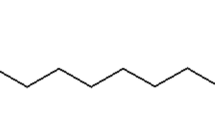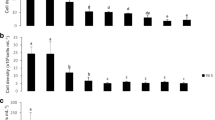Abstract
The degradation of the synthetic, amphoteric surfactant, cocamidopropyl betaine (CAPB) and its toxicity to the marine macroalga, Ulva lactuca, has been evaluated using several different physiological test end-points over different periods of exposure up to 120 h. Droplet surface angle measurements revealed that, following a period of acclimation of about 24 h, CAPB began to degrade and that primary degradation was complete within 120 h. Effective quantum yield (∆F/Fm′) and relative growth rates (RGRs) were the most sensitive measures of phytotoxicity, with CAPB concentrations at and above 10 mg l−1 eliciting irreversible, time-dependent and/or dose-dependent responses. Cell membrane damage, estimated from measurements of ion leakage, was detected only at a concentration of 40 mg l−1 after 48 h of exposure to CAPB but by 120 h damage was evident at all measured concentrations above 10 mg l−1. These observations suggest that both CAPB and its metabolites are intrinsically toxic to U. lactuca. The findings of this study are discussed in terms of the environmental consequences of applying CAPB to control harmful algal blooms.





Similar content being viewed by others
References
Brown MT, Newman JE (2003) Physiological responses of Gracilariopsis longissima (SG Gmelin) Steentoft, LM Irvine and Farnham (Rhodophyceae) to sub-lethal copper concentrations. Aquat Toxicol 364:201–213
Brunner C, Baumann U, Pletscher E, Eugster M (2000) Total degradation or environmental experiment. Tenside Surfact Det 37:276–280
Cserháti T, Forgacs E, Oros G (2002) Biological activity and environmental impact of ionic surfactants. Environ Int 28:337–348
Eichhorn P (2001) Surfactants and their aerobic degradation products: formation, analysis and occurrence in the aquatic environment. Dissertation, University of Mainz, p 195
Eichhorn P, Knepper TP (2001) Electrospray ionization mass spectrometric studies on the amphoteric surfactant cocamidopropylbetaine. J Mass Spectrom 36:677–684
Frömel T, Knepper TP (2008) Mass spectrometry as an indispensable tool for studies of biodegradation of surfactants. Trends Analyt Chem 27:1091–1106
Garcia MT, Campos E, Marsal A, Ribosa I (2008) Fate and effects of amphoteric surfactants in the aquatic environment. Environ Int 34:1001–1005
Garland JL, Levine LH, Yorio NC, Hummerick ME (2004) Response of graywater recycling systems based on hydroponic plant growth to three classes of surfactants. Water Res 38:1952–1962
Glover RE, Smith RR, Jones MV, Jackson SK, Rowlands CC (1999) An EPR investigation of surfactant action on bacterial membranes. FEMS Microbiol Lett 177:57–62
Gonzalez S, Barcelo D, Petrovic M (2007) Advanced liquid chromatography-mass spectrometry (LC-MS) methods applied to wastewater removal and the fate of surfactants in the environment. Trends Analyt Chem 26:116–124
Han Y-K, Brown MT, Park GS, Han T (2007) Evaluating aquatic toxicity by visual inspection of thallus color in the green macroalga Ulva: testing a novel bioassay. Environ Sci Technol 41:3667–3671
Koch U, Glatzle D, Ringenbach F, Dunz T, Stegerhartman T, Wagner E (1995) Measurement of ion leakage from plant-cells in response to aquatic pollutants. Bull Environ Contam Toxicol 54:606–613
Lewis MA (1990) Chronic toxicities of surfactants and detergent builders to algae: a review and risk assessment. Ecotoxicol Environ Safe 20:123–140
Li H, Miao J, Cui F, Li G (2008) Surfactant promotion of the inhibitory effects of cupric glutamate on the dinoflagellate Alexandrium. J Phycol 44:1364–1371
Madsen T, Boyd HB, Nylén D, Pedersen AR, Petersen GI, Simonsen P (2001) Environmental and health assessment of substances in household detergents and cosmetic detergent products. Environmental Project No 61, Miljǿprojekt, CETOX, pp 87–93
Masakorala K, Turner A, Brown MT (2010). Toxicity of synthetic surfactants to the marine macroalga, Ulva lactuca. Water Air Soil Pollut (in press)
Mayer LM, Schick LL, Self RFL, Jumars PA, Findlay RH, Chen Z, Sampson S (1997) Digestive environments of benthic macroinvertebrate guts: enzymes, surfactants and dissolved organic matter. J Mar Res 55:785–812
Pavlić Z, Vidaković-Cifrek Z, Puntarić D (2005) Toxicity of surfactants to green microalgae Pseudokirchneriella subcapitata and Scenedesmus subspicatus and marine diatoms Phaeodactylum tricornutum and Skeletonema costatum. Chemosphere 61:1061–1068
Popova A, Kemp R (2007) Effects of surfactants on the ultrastructural organization of the phytoplankton, Chlamydomonas reinhardtii and Anabaena cylindrica. Fundam Appl Limnol 169:131–136
Ralph PJ, Smith RA, Macinnis-Ng CMO, Seery CR (2007) Use of fluorescence-based ecotoxicological bioassays in monitoring toxicants and pollution in aquatic systems: review. Toxicol Environ Chem 89:589–607
Rosen M, Li F, Morrall SW, Versteeg DJ (2001) The relationship between the interfacial properties of surfactants and their toxicity to aquatic organisms. Environ Sci Technol 35:954–959
Sellner KG, Doucette GJ, Kirkpatrick GJ (2003) Harmful algal blooms: causes, impacts and detection. J Ind Microbiol Biotechnol 30:383–406
Sun X-X, Han K-N, Choi J-K, Kim E-K (2004) Screening of surfactants for harmful algal blooms mitigation. Mar Pollut Bull 48:937–945
Tarng JJ, Reich C (2006) Shampoos and conditioners. In: Lai K-Y (ed) Liquid detergents. Taylor and Francis, Boca Raton, pp 377–450
Torres LG, Lemus X, Urquiza G, Verdejo A, Iturbe R (2005) Surfactant enhanced washing of drilling fluids, a promising remediation technique. Tenside Surfact Det 42:347–355
Turner A, Pollock H, Brown MT (2009) Accumulation of Cu and Zn from antifouling paint particles by the marine macroalga, Ulva lactuca. Environ Pollut 157:2314–2319
Venhuis SH, Mehrvar M (2004) Health effects, environmental impacts and photochemical degradation of selected surfactants in water. Int J Photoenergy 6:115–125
Acknowledgments
We thank Lankem Ltd, Cheshire, United Kingdom for supplying the CAPB. Technical support by Nick Crocker and Peter Bond is gratefully acknowledged.
Author information
Authors and Affiliations
Corresponding author
Rights and permissions
About this article
Cite this article
Vonlanthen, S., Brown, M.T. & Turner, A. Toxicity of the amphoteric surfactant, cocamidopropyl betaine, to the marine macroalga, Ulva lactuca . Ecotoxicology 20, 202–207 (2011). https://doi.org/10.1007/s10646-010-0571-3
Accepted:
Published:
Issue Date:
DOI: https://doi.org/10.1007/s10646-010-0571-3




